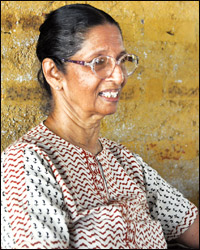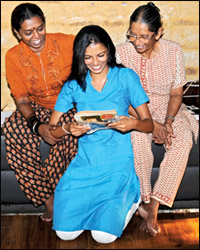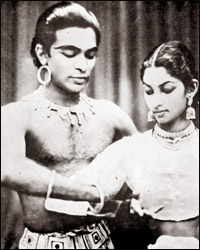|
Vajira turns 78 today:
Lanka’s grand dame of dance
Jayanthi Liyanage
Kalasuri Vajira Chitrasena, the grand dame of dance in Sri Lanka,
celebrates her 78th birthday today. Svelte and lithe in figure and
sinous and lyrical in her movements, she is legendary for her
contribution to dance, together with her late husband Chitrasena and now
with her daughters Upeka and Anjalika and her grand daughters.
|

Vajira Chitrasena |
|

Upeka, Thaji, Vajira – three generations of dancers. Pictures:
Saman Sri Wedage |
It is said that Vajira is the greatest female dancer to emerge in Sri
Lanka after Chandralekha. For every birthday of Vajira, an educative
ritual dance is held.
On March 20, at 5.30 pm, a fertility ritual dance called Rata Yakuma
will be held at the Chitrasena Kalayathanaya for the benefit of
students. Vajira scans her memories of dance for the Daily News.
Q. When you look back at your life as
a dancer, what seems important to you?
A. When I started dancing
I was just a child. It was with Chitra’s influence that I became an
artiste of dance and choreography. Until then I was a schoolgirl going
to school from their house. After I became an important person in the
group of dancers that he had, I started being creative. My first
children’s ballet, Kumudini, was done to a song of Ananda Samarakoon in
1952, when I was 19 years old. Thereafter, every two years or so, there
was a new creation. That was my main contribution to the dance, which
was learning to create dances and do children’s ballets, which is quite
new to the country. I was also the first professional female dancer of
the country. Before me, others had danced but they did not regard dance
as a serious subject. Through me, a woman’s dance was created for the
Kandyan dance.
Q. What stands out in your memories
of dancing with Guru Chitrasena?
A. We did together all the
work. His main ballet with many years of experiment was Karadiya. We
took Karadiya all over the world, even to Russia. It was a great
achievement for Chitrasena and my collaboration helped him do it. I take
forward what Chitrasena did. He introduced ritual dance to the stage. He
went to village, found gurus and learnt ritual dances. His father was
also a theatre person, staging plays at Tower Hall. Artistry was in the
family. Chitra as a child, imbibed all those things. After his return
from India where he learnt dance, he brought in implements of modern
theatre - lighting and costumes - on stage. We must
|

Chitrasena |
remember that Somabandu Vidyapathy had new ways of presenting our
culture in costumes as well. He created all my early costumes, with the
head dress which was the first woman’s costume in dance.
Q. It is said that you gave a
feminine touch to the Kandyan dance.
A. That comes through
constant years of dancing. When you polish anything for years and years,
something has to come out of it. The female style developed through me.
Theatre-wise, Chitrasena created the idea of ballet, the story behind
the dance. Earlier, there was only dance movements without any meaning.
When I was doing the dance of swan in Nala Damayanthi, some thought I
had copied from the West. A critic in Australia realized that the
origins of Swan Lake had been in the East.
“Balletomones who see the second program of the Chitrasena
ballet....will receive a shock, for there they will find the original of
the beloved classical-romantic ballet Swan Lake...The critic has not
seen in Western ballet mime, acting and dancing, capable of evolving the
nature and spirit of the swan, to compare with the performance of Vajira
in her role.” (The Sydney Morning Herald, 1963).
Q. What are the qualities that make a
good female dancer?
A. You must have a good
figure and a dedication to the dance. I was fortunate in that I had a
figure that suited dance since I was sixteen. If you are very heavy, you
can’t do jumps and turns.
Q. What do you think of the position
of dance in Sri Lanka today?
A. Today, mostly because
of the television, people copy from very cheap kind of dancing. They
don’t go deep into the dance to learn it. If there are hip wriggling
movements, they think it is dance. You have to learn dance properly to
create anything for the stage. Imitation is easily seen in villages
because of the television. So they have a wrong picture of the dance.
Differently done is Rangabhisheka television program for which really
talented traditional dancers come from beyond
|

Vajira and Chitrasena |
Colombo. People who come from villages are better dancers.
Q. Some think that traditional dance
is not flourishing in Sri Lanka. Is it because of fusion dance and pop
trends?
A. Yes, I think so. Our
background is always traditional dance. We don’t follow trends.
Q. What do you think of the future of
modern dance in Sri Lanka?
Nuwan
Ranjit Priyanga
Carey College dance teacher speaks of
Vajira: |
Dancing and
choreography are two different fields. Vajira is the pioneer
artiste in Sri Lanka who created a dance suitable for both man
and women. The methods of teaching our traditional dances are
limited.
|

Nuwan Ranjit Priyanga |
She created new exercises for
teaching ballet.
Everybody in the Kalayathanaya practices them but her exercises
should be taught at a national level. She has created a
methodology that can be taken to an international level.
Chitrasena Kalayathnaya is now led by the third generation.
Vajira’s vision in adapting the dance to be appreciated by
Colombo’s elite society and presenting it on stage has not been
matched by any other artiste. The dances the Kalayathanaya has
produced during the past sixty years can be presented even today
without any adjustment to suit high technology. Even costumes
worn then are preserved to date.
The vast knowledge in the Kalayathanaya has still not been taken
out at a national level. Dance perpetuates on the devotion a
student has for one’s teacher. Although the third generation of
dancers in the Chitrasena Kalayathana have obtained doctorates
in theatre arts from America, they have not rejected the
creative power that has been brought forward by their elders.
|
A. There is no modern
dance. Dance is what comes out of the traditional dance which is brought
onto the stage. The stage dancing as we have created can be called
modern.
That is a different interpretation from the ritual. People
think modern dance is when you imitate the Western style and hip
wriggling styles that come from Bollywood. That is not modern dance. In
classical ballet, there is no hip wriggling. Our quality is only in our
dance, giving meaning to it.
Q. How do you see the future of your
grandchildren in their dancing careers?
A. Already they are half
way in. My three grand daughters and two daughters are in the dance. I
am content that dance will go on until they are old like me.
Q. How do you see your future?
A. I think I will continue
to be a teacher. I don’t have the strength to come on stage. But I can
create dances for the stage. There is no stopping of work. |



